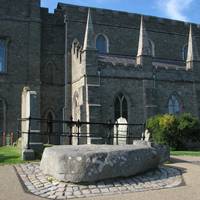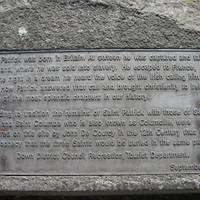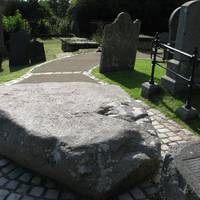
 F ONE were to look only at the secular celebration of St. Patrick’s Day, one might have no idea what the day is really about. St. Patrick, of course, was the first to bring the Gospel to the people of Ireland, whom he converted in enormous numbers. So, the heart of today’s celebration, in its origin, is a day of thanksgiving for having received the gift of faith.
F ONE were to look only at the secular celebration of St. Patrick’s Day, one might have no idea what the day is really about. St. Patrick, of course, was the first to bring the Gospel to the people of Ireland, whom he converted in enormous numbers. So, the heart of today’s celebration, in its origin, is a day of thanksgiving for having received the gift of faith.
In his Confession, St. Patrick writes this: The Lord gave me the great grace that, through me, many peoples should be reborn in God. For those of us who are actually of Irish descent, we do owe a debt to St. Patrick, in a distant, historical sense. But, more proximately, all of us have received the gift of faith at the hands of others. For many, the faith has been received through parents or grandparents, friends or co-workers. For others, perhaps it was a particular author whose writings inspired a conversion.
Today would be a good day to call to mind that person and offer a prayer of thanksgiving for the gift of faith—a gift that lies beyond all price.

 NOTHER worthwhile way to mark today’s feast might be to pray one of the most treasured Irish devotions, the Lorica (Breastplate) of St. Patrick. A good rendering of the text is available here. Portions of an illuminated version crafted by the Manx designer, Archibald Knox, are also available online.
NOTHER worthwhile way to mark today’s feast might be to pray one of the most treasured Irish devotions, the Lorica (Breastplate) of St. Patrick. A good rendering of the text is available here. Portions of an illuminated version crafted by the Manx designer, Archibald Knox, are also available online.
This prayer, traditionally ascribed to St. Patrick and likely actually composed in the 5th century, comes to us through the Liber hymnorum, an 11th-century manuscript containing 40 hymns in Latin and Gaelic.
This ancient Irish hymn has been set to music often in modern times. The most common metrical version is the hymn I Bind Unto Myself Today, written in 1889 by Cecil Frances Alexander, a remarkable woman who also authored Once in David’s Royal City and All Things Bright and Beautiful. A beautiful unaccompanied, SATB setting of the last stanza of the Lorica is published through CanticaNOVA (available here).

 N 2015, I had the pleasure of visiting Downpatrick in County Down (Northern Ireland), traditionally regarded as the burial site of Saints Patrick, Brigid, and Columbkille (my Confirmation patron). Here are a few photographs of the site:
N 2015, I had the pleasure of visiting Downpatrick in County Down (Northern Ireland), traditionally regarded as the burial site of Saints Patrick, Brigid, and Columbkille (my Confirmation patron). Here are a few photographs of the site:
Thy blessed confessor and bishop,
to preach Thy glory among the nations,
mercifully grant, by his merits and intercession,
that we may be able to accomplish
that work which you command us to do.
Through our Lord, Jesus Christ, Thy Son,
who lives and reigns with Thee
in the unity of the Holy Spirit,
God, forever and ever. Amen.
Collect for the Feast of St. Patrick




